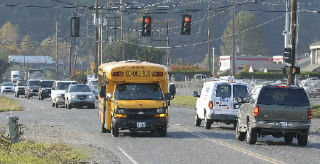The Stewart Road Corridor widening project will upgrade the route from East Valley Highway to State Route 167, building two driving lanes in each direction and a two-way left-turn lane, plus bicycle and pedestrian facilities, new pavement and signal upgrades.
A four-phase, $40 million project, it is the last step in completing the entire Lake Tapps Parkway-Stewart Road corridor from 182nd Avenue to SR 167.
To put it plainly, the project will create a way down from the Lake Tapps plateau and the White River Valley to 167. The cities of Auburn, Pacific, Sumner and Pierce County are keen to see it happen.
But it isn’t happening.
And the reason it’s not happening is money. The big problem, according to the three cities partnering with Pierce County to build it, is the county’s failure to live up to the commitment it made more than a decade ago to pony up its share of the funds.
Wednesday evening, officials from the cities of Auburn, Pacific and Sumner and interested citizens gathered in the Lakeland Hills Elementary gymnasium to talk about it.
At issue is a project lacking the $25 million needed to finish it.
Phase 1, from SR 167 to Valentine or 136th Avenue, estimated to cost $10.3 million, is short $3.4 million. Phases II – Valentine to White River, $10 million, and III, White River Bridge, $11.3 million – are unfunded.
On the other hand, said Mike Dahlem, city engineer for the City of Sumner, Phase 4, White River Bridge to Lake Tapps Parkway East, estimated cost $7.8 million, is completely funded.
Existing Pierce County agreements show that the City of Pacific is responsible for 64 percent of the costs of the first and second phases, while Pierce County is responsible for 36 percent. As for the third and fourth phases, the City of Sumner is responsible for shouldering 29 percent and Pierce County 71 percent.
Grants received are taken off the top of the funding need before calculating each jurisdiction’s financial share. The problem is that smaller cities like Pacific and Sumner don’t have the deep pockets to fund such a large percentage of the project, so it has stalled.
But the fact nobody can ignore is that, according to traffic counts the City of Auburn took in 2007 and 2008, usage for the existing corridor breaks down among the jurisdictions as follows: City of Auburn, 5 percent; City of Pacific, 13 percent; City of Sumner 9 percent; and unincorporated Pierce County 73 percent.
“Pierce County is going to have to come back to the table and recognize where the bulk of the traffic is coming from and the development and try to move these projects towards completion,” concluded Jay Bennett, Community Development-Public Works Director for the City of Pacific.
State Sen. Pam Roach said the problem is that the area is almost on the border of King and Pierce counties and “we’re everybody’s second cousin,” the last on the list when it comes to project funding.
Auburn Mayor Pete Lewis explained how the stalled project is affecting his city.
“When Lakeland Hills was first conceived, Pierce County was trying to find a way to get traffic off the hillside, hence the concept of a Lake Tapps Parkway.” Lewis said. “This city put in its commitment for the transportation impact fees to go to the parkway. It also demanded that the developer, and pretty much at full cost, put up money to build the parkway to the bottom of the hill with the commitment that Pierce County was going to build the parkway to 167.
“We knew full well that if all the traffic to Lakeland Hills-Lake Tapps couldn’t come down the parkway, it would flood our city streets. And that’s exactly what’s taking place.” Lewis said. “We’re waiting to see Pierce County complete its committment to build the Lake Tapps corridor. Pierce County committed to this in the early ‘90s, and since then there have been changes in elected officials and staff. But the agreement is still there, and the costs keep going up.”
=====
PROJECT BENEFITS
• Provide a 5-lane regional route linking citizens of Auburn, Pacific, Sumner and rural northeastern Pierce County to State Route 167
• Upgrade and synchronize signals
• Provide a truck route for regional commerce
• Create continuous pedestrian and bicycle facilities along the corridor
• Accommodate existing and projected growth in north Pierce County over the next 20 years. Right now, 15,000 vehicles use the roadway daily, 1,600 or 11 percent of them heavy trucks. By 2025, projections show, 40,000 vehicles, including 6,000 heavy trucks, will use the corridor every day.



